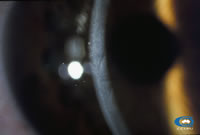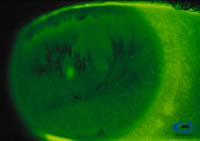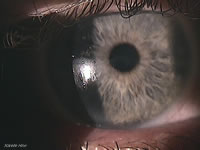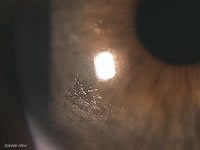The advent of silicone hydrogels has revitalised my presbyope
contact lens practice, especially for hyperopes. The proven optimal
oxygen transmissibility of silicone hydrogels at last allows
hyperopes the opportunity to successfully and safely try 30 night
continuous wear (CW)- a very popular option with presbyopes because
they are so visually challenged at near they cannot easily see
to insert or handle their contact lenses. Until the release of
silicone hydrogels all published oxygen transmissibility research
has contraindicated closed eye wear of all plus hydrogel lenses.
My clinical experience with presbyopic hyperopes has shown that
corneal hypoxia as indicated by the presence of stromal striae
and folds, commonly occurs with LWC and MWC lenses after only
4 - 8 hours of daily wear.
 |
| Endo
Folds - click to enlarge |
The higher the plus power of the lens,
the less the average oxygen transmissibility of the lens and
the greater the corneal hypoxia resulting in corneal oedema.
This difference in striae response is classically demonstrated
in comparative slit lamp examination of the stroma in a monovision
wearer e.g. OD +3.00D vs OS +5.50D. Presbyopes may require even
more consideration in choice of lenses than younger patient populations.
The gradual changes to the integrity and function of the corneal
endothelium with age affects the ability to efficiently control
corneal hydration. The longterm effect on the endothelium of
swelling and deswelling of the corneal stroma and epithelial
fragility is as yet not well understood. Consequently to avoid
hypoxia I have adopted the policy of fitting all my hyperopic
patients with lens materials of at least 70% WC for daily wear.
Apart from slower recovery from hypoxia, many presbyopes also
show the additional challenge to hydrogel lens wear of an unstable
tear film leading to dry eye, more prevalent in post menopausal
women.
 |
| Dry Eye - click to enlarge |
Studies suggest that the major cause of their
tear instability in normal aging presbyopes is less to do with
reducing tear volume and the lipid layer and more related to
the strength of the tear binding interface at the corneal epithelium
and the efficiency of the blink action to reform the tear film.
Compared to earlier generation lenses, the surface treated silicone
hydrogels provide good wettability, good tear deposit resistance
and a low WC demand of the polymer assists eyes with less than
perfect tear film to maintain wear.
However adequate tear film stability and volume
is still essential for success with CW. Persistent symptoms of
dry eye affect 10 - 15% of CW candidates and cannot be usefully
managed with lubricants. Dry eye remains the chief cause for
discontinuation from CW for both young and presbyope patient
groups in my practice.
 |
 |
| Lipid Deposits - click to enlarge |
Mucin Deposits - click to enlarge |
For the past two years I have monitored at six monthly intervals
a small group of eight 30 night CW hyperopic presbyopes (age
range 56 to 70 years) whom I fitted with monovision silicone
hydrogels (BVP range +1.25D to +6.00D). To date there has been
no striae/fold or microcyst response in either eye which indicates
the lenses are as safe for CW hyperopes as myopes. The patients
love their lenses and are very grateful for the round the clock
convenience. |